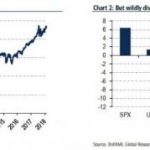The incredibly shrinking junk bond spread just passed a historic landmark when the Bloomberg Barclays U.S. Corporate High Yield index broke below the lowest spread since before the financial crisis this morning, dipping to 309bps, the tightest level since late 2007. This means that the extra yield over U.S. Treasuries that investors demand to own USD-denominated junk debt collapsed to the least in more than a decade.

The key reason cited by analysts has been the accelerating shrinkage in high-yield supply, as last month was the slowest September for junk bond issuance since 2011, while the high yield market as a whole has been contracting as investors have shifted their focus to leverage loans where demand, as discussed recently, has been unprecedented.
Meanwhile, fed hikes have been rising all boats, pushing debt yields across the fixed income space higher, however unlike investment grade bonds, they have a more nuanced impact on junk which is another reason why the spread has been contracting. That said, once the time comes to refinance, these issuers may feel pain as they find themselves rolling debt into notably higher interest rates. Meanwhile, thanks to the strong economy, earnings even for the distressed sector have been solid with no unexpected blow ups (think the energy sector in the aftermath of the oil recession in late 2015/early2016).
The biggest winners in the half were pharmaceutical names, but virtually every other industry group has outperformed with the obvious exception of department stores. The picture for automakers has been mixed too, although here the catalyst has been rising costs due to tariffs and confusion over Brexit: Jaguar Land Rover bonds have done worse than Tesla’s, while Fiat Chrysler’s have outperformed the broader index, according to Bloomberg.
The collapse in spreads has been a boon to hedge funds, with distressed debt investors generating a 6.6% return through August, outperforming the overall 0.3% gain for the broader industry and the negative total return for Investment Grade bonds.













Leave A Comment